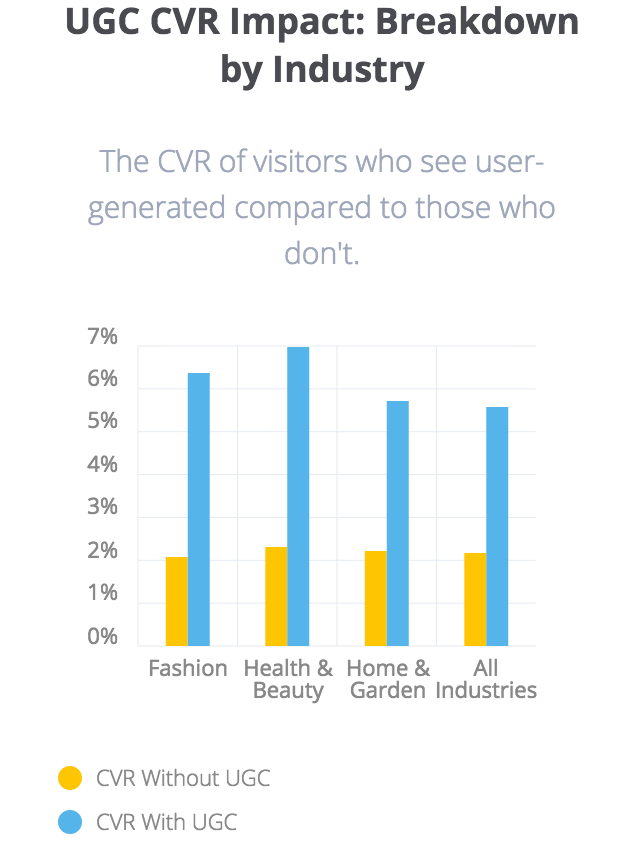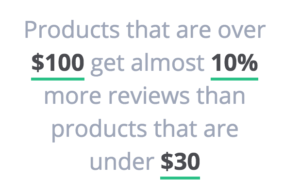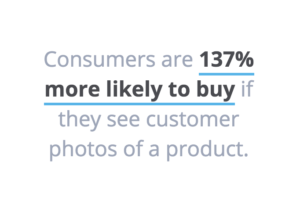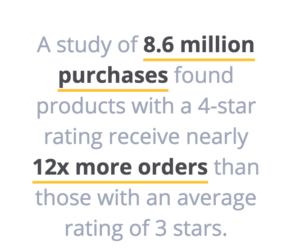It’s coming: The most wonderful time of the year — at least for retailers.
For many stores, holiday shopping makes up the bulk of yearly revenue. For Amazon, Q4 accounts for 33.4% of annual sales. And the sheer volume of purchases is almost unbelievable. November and December retail sales in the U.S. alone reached $658.3 billion last year, up $32.2 billion from 2015, according to data from the National Retail Federation.
While it’s easy to rely on major discounts, ads, and the magic of the shopping season to take effect, there’s a lot more you can do to prepare. Now is the time to make sure the user-generated content on your site is optimized to reap the benefits of Black Friday, Cyber Monday, and holiday shopping.

See more Data Points here.
You can get a bigger chunk of this year’s holiday sales by helping shoppers easily find all the information they need to hit “add to cart” without hesitation.
Shoppers want authentic information
Holiday shoppers begin researching products in October and even earlier. Whether they walk into your brick and mortar store or order from their mobile phone on the way to work, by the time most shoppers are ready to buy, they know what their options are. They spend time learning about how similar products and their price points compare. They read reviews to understand prior customers’ experiences, and they seek out customer photos for a truer sense of what products look like and how they are used by real people.
- 92% of consumers read online reviews
- 88% of consumers trust reviews as much as personal recommendations
- 72% of consumers will act only after reading a positive review
It doesn’t matter whether you’re selling products at a lower or higher price point. NRF data shows that 66% of consumers research products that cost less than $50, while 85% of consumers research products that cost between $50 – $100.
However, if you want to stand out to consumers, just having reviews on your site is not enough.
Cover all your bases
You might have tons of reviews of your best-selling products, but when shoppers are on your site for the first time (which happens a lot this time of year) it’s important that they see an even distribution of reviews across all your products.
Consistently adding new reviews to your entire range of products before the holiday rush is crucial.
Gathering those reviews at the last minute might seem overwhelming, but here are a few strategies to do so quickly and efficiently.
- Make leaving a review super simple. Send your past customers review request emails that streamline the process, and let them share their thoughts in a matter of a couple of clicks.
- Reach out to past customers when they’re likely to be online. The right timing can make or break the response rate for review request emails.
- It’s never too late to retroactively ask customers to send in a review. Past purchases are not a missed opportunity. Try sending review requests to customers who bought from your store up to three months ago.
- Offer an incentive to customers for writing reviews. Loyalty points, coupons, discount codes, or even the chance to win a prize will motivate customers to share their thoughts.
- If you’re worried about not having enough reviews for similar products, try grouping those items and syndicating reviews across items for better product coverage. For example, if your blue and green rain boots have 5 reviews each, show those reviews on the product page for your black rain boots, too.
- Seek reviews for the most expensive items in your customers’ shopping carts. Shoppers are more likely to write reviews for pricey products.

See more Data Points here.
Enhance credibility: Negative reviews can help
Since 81% of Gen Zers and 75% of Millennials tend to leave reviews, there’s bound to be a few negative ones in the mix. This is actually a good thing, as 95% of consumers won’t believe feedback that is strictly positive.
Publishing negative reviews along with the positive is important at any time of year, but it’s extra impactful in the lead up to Black Friday and Cyber Monday, because shoppers are more likely to research and buy from new brands now. Having the odd negative review on your site will help you establish credibility with these new consumers.
When you receive negative reviews, best practice is to reply quickly and courteously, since 53% of consumers say they would expect a reply, and 93% of those shoppers say their loyalty to the brand would be diminished without one. Plus, consider the countless other shoppers who will see the complaint and read your response — the right reply will draw them into your brand for your dedication to customer satisfaction. When you handle negative reviews properly, you can even turn a customer who had a bad experience into a loyal customer.
Customer photos are worth a thousand words
In addition to rounding out your reviews coverage, and handling negative reviews effectively on-site, your store also needs to be in tip-top shape when it comes to visual user-generated content.
In fact, 74% of shoppers prefer reviews with photos or videos and 77% want to see user-generated photos instead of professional ones.

See more Data Points here.
People love to share experiences. Seeing other customers using a product helps shoppers visualize themselves using the product, making them more likely to buy. Authentic content like customer photos is a powerful way to provide social proof, build trust, and boost conversions.
As consumer attention shifts to visual content on social platforms, channels like Instagram and Pinterest are taking over. The good news for brands is that your customers are already posting photos of your products on these channels organically — so all you have to do is collect the best ones and share them on your site (with permission, of course).
Bringing the visual experience from those social channels to your site is key for keeping your brand relevant and meeting shopper expectations for both product discovery and purchase path. Not only that, but making your on-site experience stand out with authentic and attractive visual content will give you an edge in the massive competition for consumer attention ahead of Black Friday.
In addition to curating from social, you can also add visual user-generated content to your site by asking for photos from your customers when you ask for reviews.
If you’re in a rush to collect visual content ahead of Black Friday and Cyber Monday, try running an Instagram campaign to gather a ton of photos in no time at all. Create a photo contest with a brand-focused hashtag, and offer a giveaway for the best photo. This will not only give you more content, it will also help create a buzz around your brand as the sales kick off.
Help your customers do better research
Introduce your customers to products similar to the ones they are already searching for. For instance, if a customer is looking for running shoes, recommend similar styles in various colors or materials.
You can do this by displaying images of other styles of athletic shoes on related product pages and tagging them as “recommended products.” This way, shoppers don’t have to go looking for more options on other sites.

See more Data Points here.
Make sure to showcase the star rating of each recommended product to attract shopper attention. Showing that social proof right off the bat pays off: 28% of US female internet users reported that they would spend up to 10% more on products with positive reviews.
Black Friday And Cyber Monday Sum Up
Most holiday shoppers start their research in October or even earlier, and they’re looking for customer reviews and photos to help them make purchase decisions. Tweaking your site to optimize your user-generated content strategy will put you ahead of your competition and set you up for a Black Friday that you won’t forget.


